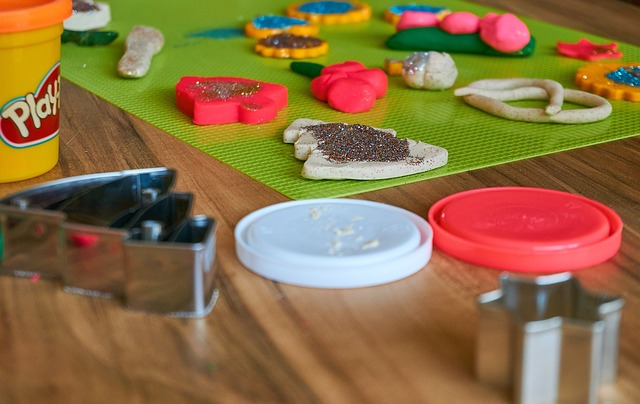Baby Ate Play-Doh
Parents often worry when their child accidentally eats Play-Doh. If your baby, toddler, or child ate Play-Doh, you’re probably concerned and seeking answers. In this comprehensive guide, we will explore the potential dangers and actions to take when a child ingests Play-Doh.
What is Play-Doh?
Play-doh is a modeling clay that has been popular among kids for decades. It’s soft, easy to manipulate, and available in various colors, making it an ideal tool for creative play. Commercially available Play-Doh is made of water, salt, flour, and a few other ingredients, while homemade Play-Dough recipes typically include similar components.
Is Play-Doh Toxic?

Play-doh is non-toxic and rigorously tested to ensure its safety. In most cases, if you eat Play-Doh in small amounts, it is minimally toxic and not a cause for serious concern. However, large quantities can pose risks due to high sodium content, allergens, and other ingredients.
Play-Doh Ingredients:
The ingredients in commercial Play-Doh typically include water, salt, flour, mineral oil, and various other ingredients depending on the specific formulation and color. Play-Doh may also contain small amounts of fragrance, preservatives, and other additives. Homemade Play-Doh recipes often include similar ingredients, such as flour, salt, water, and oil, but may also include food coloring and other optional ingredients.
Commercial Play Doughs Vs. Homemade Play Dough
Commercial play doughs and homemade play dough both have their advantages and disadvantages. While commercially available play dough is tested for safety, homemade play dough allows you to control the ingredients used, making it suitable for kids with allergies or specific dietary restrictions.
What to Do When a Child Eats Play Dough
When children eat play-doh, please follow these instructions:
Immediate Actions
- Remain calm and assess the situation.
- Check for any symptoms or signs of distress.
- Remove any remaining play doh from the child’s mouth.
- Contact a medical professional or poison control center for advice.
Possible Symptoms
Ingesting play doh may cause abdominal pain, vomiting, or diarrhea due to its high salt content. If your kid ate Play-Doh and experiences these symptoms, seek medical attention.
Poison Control Center
If you’re unsure how to proceed, contact your local poison control center or a medical professional for guidance. They can provide advice based on the specific situation and your child’s symptoms.
Choking Hazards
Ingesting large amounts of play dough can be a choking hazard. If your child is choking, perform the Heimlich maneuver or seek emergency medical help immediately.
Allergic Reactions
Some children may have an allergic reaction to ingredients in Play-Doh, such as wheat gluten. If your kid ate Play-Doh and shows signs of an allergic reaction, seek medical attention.
Preventing Your Child Eating Play-Dough
Teach Kids
Educate your children about the dangers of eating Play-Doh and explain that it’s not food. Make sure they understand the difference between Play-Doh and edible items.
Childproof Your Home
Store Play-Doh and other non-edible items out of reach of young children. Consider using childproof containers or locks on cabinets where play doh is stored.
Supervise Playtime
Always supervise playtime with Play-Doh, especially for younger children who might be more likely to put it in their mouths. Keep an eye on your child while they’re playing to prevent accidental ingestion.
Homemade Play-Doh Recipes
Creating homemade play dough can be a fun and safe alternative to commercial play dough. There are many recipes available online that use simple, non-toxic ingredients like flour, salt, and food coloring. Some even substitute coconut oil for a more natural and allergy-friendly option. Experiment with various recipes to find one that suits your child’s needs and preferences.
Making homemade playdough is a fun and easy activity that parents can do with their children. Not only does it allows parents to control the ingredients and ensure that the play dough is safe and non-toxic, but it also is a great way to spend quality time together, Here’s a step-by-step guide to making homemade play dough that kids will love to play with:
Ingredients:
2 cups of all-purpose flour (wheat gluten, raw flour)
1/2 cup of salt
2 tablespoons of cream of tartar
2 tablespoons of vegetable oil (coconut oil works as well)
1 1/2 cups of boiling water
Food coloring (optional)
Instructions:
In a large bowl, mix together the flour, salt, and cream of tartar.
Add the vegetable/coconut oil to the bowl and stir until well combined.
Add the boiling water to the bowl and stir vigorously until the mixture forms a smooth dough.
If you want to add color, divide the dough into smaller portions and add a few drops of food coloring to each portion. Knead the dough until the color is evenly distributed.
Store the play dough in an airtight container or plastic bag.
Tips:
You can experiment with different colors and scents by using different types of food coloring or adding a few drops of essential oils.
If the dough is too dry, add a few drops of water until it reaches the desired consistency. If it’s too sticky, add a bit more flour.
Be sure to read labels and research potential allergens before using any new ingredients.
Play-Doh Alternatives
If you’re concerned about your child eating Play-Doh, consider using alternative modeling clays or doughs. Many non-toxic, child-safe alternatives are available on the market. Be sure to read labels and research any potential allergens before introducing new products to your child.
Conclusion
While playdoh ingestion is generally not dangerous, it’s essential to be aware of the potential risks and take appropriate steps to prevent accidents. By teaching your child about the dangers of eating Play-Doh, childproofing your home, and supervising playtime, you can help keep your child safe. Exploring homemade play dough recipes or alternative products can also provide peace of mind while still encouraging your child’s creativity.
FAQs
Is play doh toxic for children?
No, play-doh is non-toxic and minimally toxic when ingested in small amounts. However, large amounts can pose risks due to high sodium content, allergens, and other ingredients.
What should I do if my child ate Play-Doh?
First, remain calm and assess the situation. Remove any remaining play doh from the child or toddler’s mouth, and contact a medical professional or poison control center for advice.
Can homemade play dough be safer than commercial play dough?
Homemade play dough allows you to control the ingredients used, making it suitable for kids with allergies or specific dietary restrictions. However, commercial playdoh is rigorously tested for safety.
Are there any alternatives to Play-Doh?
Yes, many non-toxic, child-safe modeling clays and doughs are available on the market. Always read labels and research potential allergens before introducing new products to your child.
How can I prevent my child from eating Play-Doh?
Teach your child about the dangers of eating Play-Doh, childproof your home, and supervise playtime to prevent accidental ingestion.
Is eating Play-Doh Pica?
Eating play doh is not considered pica, which is a disorder characterized by persistent ingestion of non-food items. While play-doh is not intended for consumption, it is non-toxic and minimally toxic when ingested in small amounts. However, large quantities can pose risks due to high sodium content and other potential ingredients.


